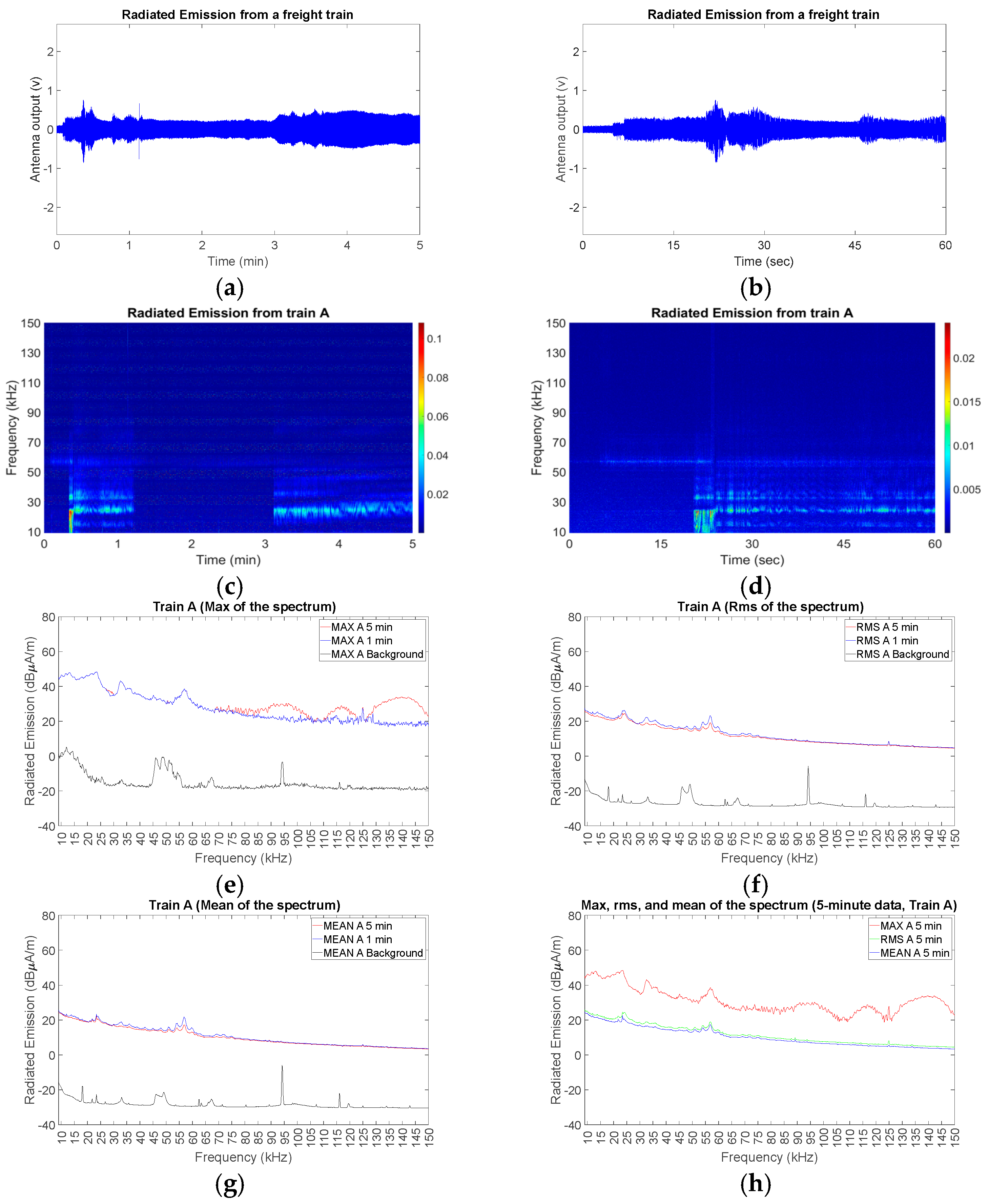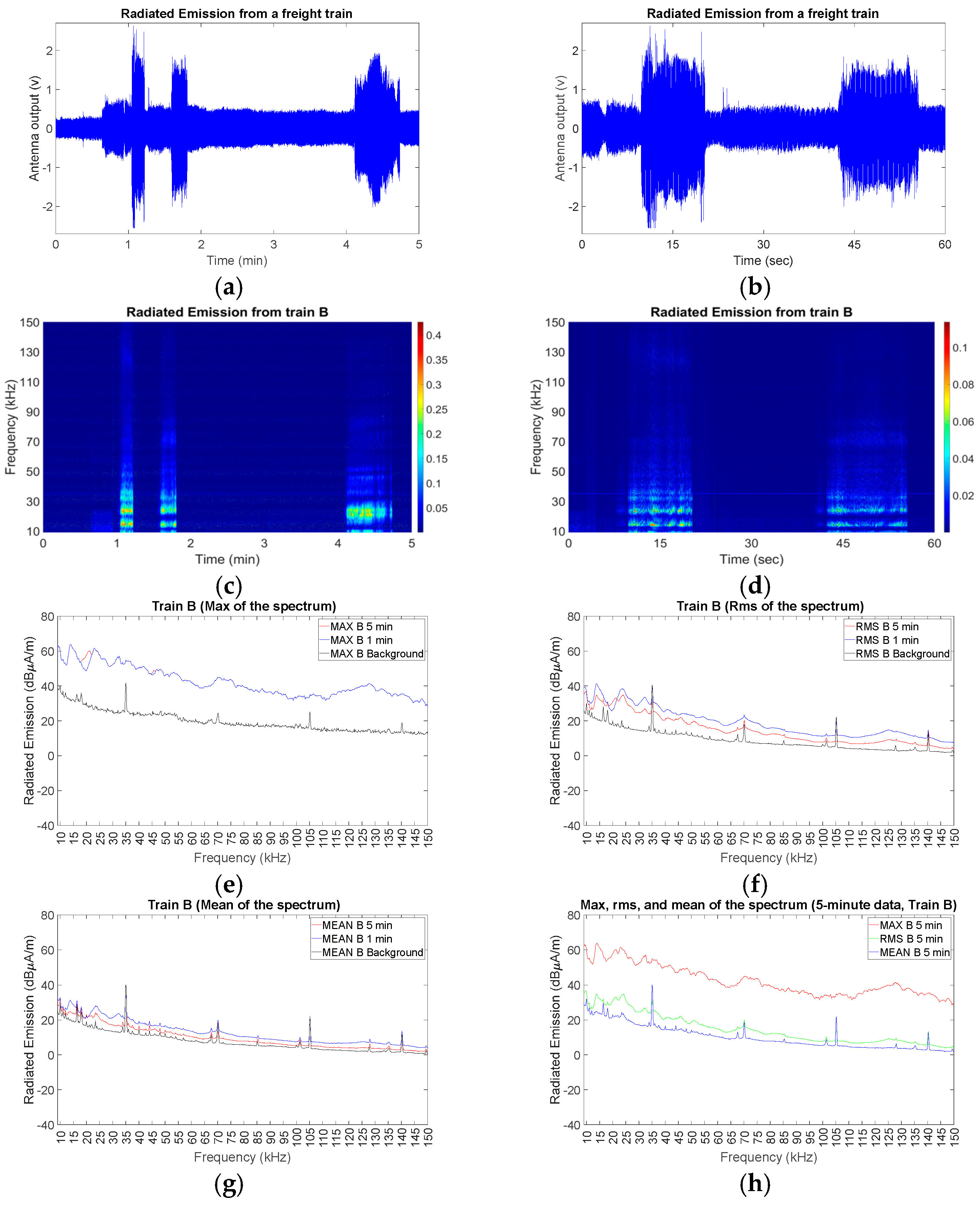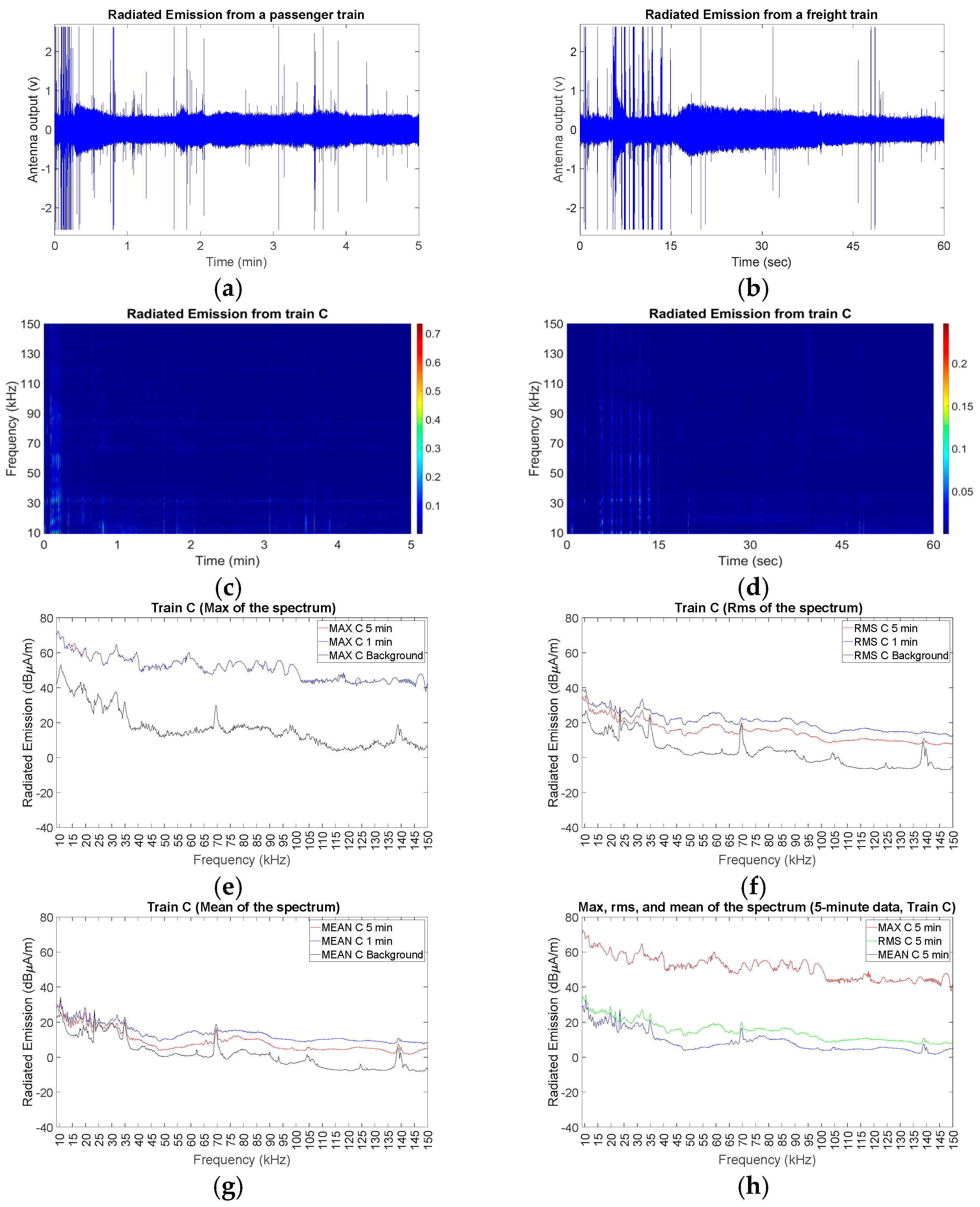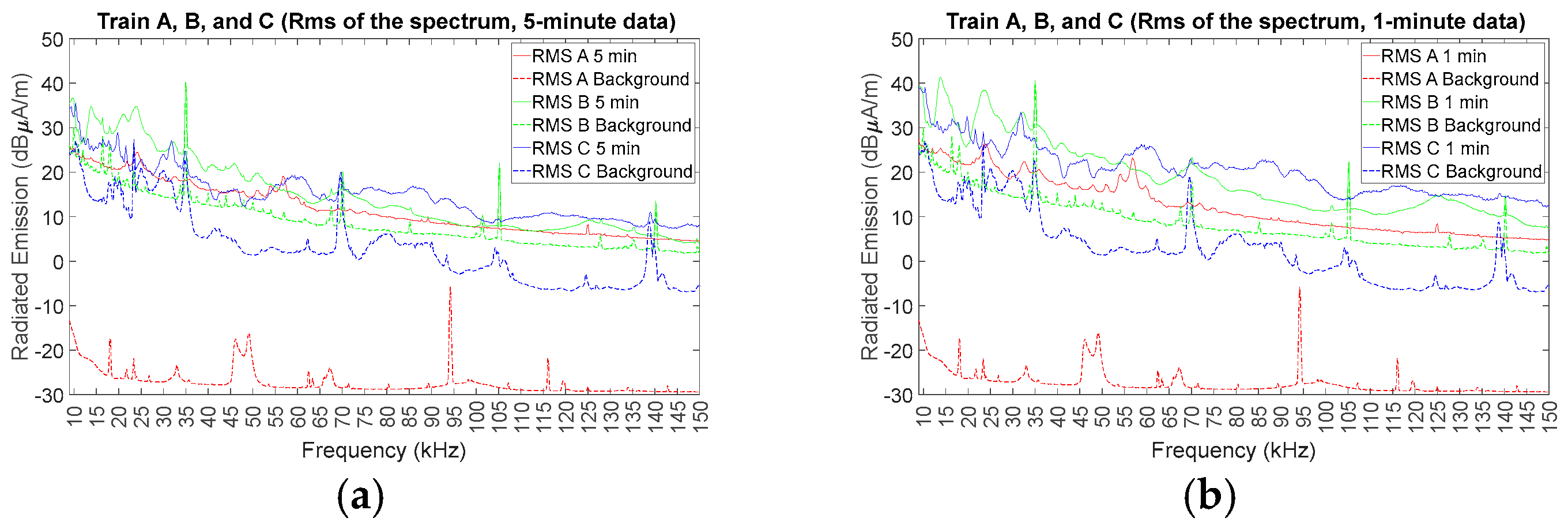Analysis of the Measurements of the Radiated Emission from 9 kHz to 150 kHz from Electric Railways
Abstract
:1. Introduction
- To perform a thorough EMC study in the design stage [4]. This method has its own complexities emanating from different causes (e.g., the designed equipment will be installed in an environment that is not always completely determined).
- To consider the concept of EMC as an operational problem that should be addressed after the installation of designed equipment in the real environment.
- Evaluating and comparing the radiated emission emanating from freight (with and without carriage) trains and passenger trains in Sweden;
- Emphasizing the importance of the time length of the signal in the time domain and its effect on the extracted frequency domain spectrum;
- Proposing other calculation methods (rms, mean, and max) of the resultant spectrum of radiated emission from different trains in the range of 9 to 150 kHz in order to compare the performance of the trains (as it is a moving source of emissions); and
- Proposing a concept of pure background measurement for future works and also emphasizing the requirement of some prerequisites (pre-, during-, and post-measurement factors), which could enhance the repeatability and reproducibility of the results.
2. Materials and Methods
3. Results
- Pure radiated emissions directly generated by the rolling stock (motors, onboard power electronics, pantograph arcing, etc.);
- Conducted emissions generated by the rolling stock and transmitted as REs by the traction line (normally a catenary wire), which radiates toward the equipment; and
- Radiated emissions generated by infrastructures such as substation equipment (e.g., static frequency convertor), high-voltage lines near the railway, improper earthing, etc.
3.1. Measurement A

3.2. Measurement B

3.3. Measurement C

3.4. A Comparison between Three Measurements



4. Discussion and Future Directions
- (1)
- Measurements in a controlled environment like a laboratory for simulating different operating modes of the train and environmental conditions like temperature and humidity. This will also facilitate making a comparative assessment between different types of trains.
- (2)
- Measurements in outdoor environments in co-ordination with train operators on the different operating modes of the train.
- (3)
- A comparison of the results of the recorded emissions with other measurements conducted across Europe and in laboratory environments needs to be taken up as part of future work.
- (4)
- Methods like machine learning [48] can be utilized in the future to identify underlying patterns that could not be identified in the present body of work.
- (5)
- Development of prediction models based on tools like artificial intelligence and machine learning [49].
5. Conclusions
Author Contributions
Funding
Data Availability Statement
Acknowledgments
Conflicts of Interest
References
- Brenna, M.; Foiadelli, F.; Zaninelli, D. Electrical Railway Transportation Systems; John Wiley & Sons: Hoboken, NJ, USA, 2018. [Google Scholar] [CrossRef]
- Morant, A.; Wisten, Å.; Galar, D.; Kumar, U.; Niska, S. Railway EMI impact on train operation and environment. In Proceedings of the International Symposium on Electromagnetic Compatibility-EMC EUROPE, Rome, Italy, 17–21 September 2012; pp. 1–7. [Google Scholar] [CrossRef]
- Mariscotti, A. Assessment of human exposure (including interference to implantable devices) to low-frequency electromagnetic field in modern microgrids, power systems and electric transports. Energies 2021, 14, 6789. [Google Scholar] [CrossRef]
- Ott, H.W. Electromagnetic Compatibility Engineering; John Wiley & Sons: Hoboken, NJ, USA, 2011. [Google Scholar] [CrossRef]
- Christopoulos, C. Principles and Techniques of Electromagnetic Compatibility; CRC Press: Boca Raton, FL, USA, 2022. [Google Scholar] [CrossRef]
- Markowska, R.; Wróbel, Z. Selected issues of safe operation of the railway traffic control system in the event of exposition to damage caused by lightning discharges. Energies 2021, 14, 5808. [Google Scholar] [CrossRef]
- Wróbel, Z.; Jagiełło, A.S. The Risk of Lightning Losses in a Structure Equipped with RTC Devices According to the Standard EN 62305-2.2008. Energies 2021, 14, 1704. [Google Scholar] [CrossRef]
- Kaleybar, H.J.; Brenna, M.; Foiadelli, F.; Fazel, S.S.; Zaninelli, D. Power quality phenomena in electric railway power supply systems: An exhaustive framework and classification. Energies 2020, 13, 6662. [Google Scholar] [CrossRef]
- Salles, R.S.; Rönnberg, S.K. Review of Waveform Distortion Interactions Assessment in Railway Power Systems. Energies 2023, 16, 5411. [Google Scholar] [CrossRef]
- Salles, R.S.; Rönnberg, S.K.; Mariscotti, A. Waveform Distortion Emission Assessment on Pantograph Measurements from Low-Frequency Railway Electrification. In Proceedings of the 2022 20th International Conference on Harmonics & Quality of Power (ICHQP), Naples, Italy, 29 May–1 June 2022; pp. 1–6. [Google Scholar] [CrossRef]
- Salles, R.S.; Rönnberg, S.K. Interharmonic Analysis for Static Frequency Converter Station Supplying a Swedish Catenary System. In Proceedings of the 2022 20th International Conference on Harmonics & Quality of Power (ICHQP), Naples, Italy, 29 May–1 June 2022; pp. 1–6. [Google Scholar] [CrossRef]
- Salles, R.S.; de Oliveira, R.A.; Rönnberg, S.K.; Mariscotti, A. Analytics of waveform distortion variations in railway pantograph measurements by deep learning. IEEE Trans. Instrum. Meas. 2022, 71, 1–11. [Google Scholar] [CrossRef]
- Mariscotti, A.; Sandrolini, L. Detection of harmonic overvoltage and resonance in AC railways using measured pantograph electrical quantities. Energies 2021, 14, 5645. [Google Scholar] [CrossRef]
- Liu, Q.; Zhang, W.; Cao, G.; Liu, J.; Ye, J.; Wu, M.; Yang, S. Influence of the Catenary Distributed Parameters on the Resonance Frequencies of Electric Railways Based on Quantitative Calculation and Field Tests. Energies 2022, 15, 3752. [Google Scholar] [CrossRef]
- Jin, M.; Yang, Y.; Yang, J.; Wu, M.; Xie, G.; Song, K. Propagation Characteristics and Identification of High-Order Harmonics of a Traction Power Supply System. Energies 2022, 15, 5647. [Google Scholar] [CrossRef]
- Liu, Q.; Sun, B.; Yang, Q.; Wu, M.; He, T. Harmonic Overvoltage Analysis of Electric Railways in a Wide Frequency Range Based on Relative Frequency Relationships of the Vehicle–Grid Coupling System. Energies 2020, 13, 6672. [Google Scholar] [CrossRef]
- Steczek, M.; Chudzik, P.; Szeląg, A. Application of a Non-carrier-Based Modulation for Current Harmonics Spectrum Control during Regenerative Braking of the Electric Vehicle. Energies 2020, 13, 6686. [Google Scholar] [CrossRef]
- Suslov, K.; Kryukov, A.; Ilyushin, P.; Cherepanov, A.; Kryukov, A. Modeling the Effects of Electromagnetic Interference from Multi-Wire Traction Networks on Pipelines. Energies 2023, 16, 4188. [Google Scholar] [CrossRef]
- Jakubowski, K.; Paś, J.; Rosiński, A. The Issue of Operating Security Systems in Terms of the Impact of Electromagnetic Interference Generated Unintentionally. Energies 2021, 14, 8591. [Google Scholar] [CrossRef]
- IEC 62236:2008; Railway Applications—Electromagnetic Compatibility. International Electrotechnical Commission: Geneva, Switzerland, 2008.
- Sadeghi, B.; Westerlund, P.; Salles, R.S.; Wilén, J. Radiated Emissions from an Electric Railway: Review of Methods and Measurements Mainly from 9 KHz to 150 KHz. In Proceedings of the International Conference & Exhibition on Electricity Distribution (CIRED 2023), Rome, Italy, 12–15 June 2023. [Google Scholar] [CrossRef]
- Mariscotti, A. Critical review of EMC standards for the measurement of radiated electromagnetic emissions from transit line and rolling stock. Energies 2021, 14, 759. [Google Scholar] [CrossRef]
- Mariscotti, A. The Electrical Behaviour of Railway Pantograph Arcs. Energies 2023, 16, 1465. [Google Scholar] [CrossRef]
- Jin, M.; Hu, M.; Li, H.; Yang, Y.; Liu, W.; Fang, Q.; Liu, S. Experimental Study on the Transient Disturbance Characteristics and Influence Factors of Pantograph–Catenary Discharge. Energies 2022, 15, 5959. [Google Scholar] [CrossRef]
- Li, X.; Zhu, F.; Lu, H.; Qiu, R.; Tang, Y. Longitudinal propagation characteristic of pantograph arcing electromagnetic emission with high-speed train passing the articulated neutral section. IEEE Trans. Electromagn. Compat. 2018, 61, 319–326. [Google Scholar] [CrossRef]
- Persichini, R.D.; Di Febo, D.; Calà, V.; Malta, C.; Orlandi, A. EMC analysis of axle counters in the Italian railway network. IEEE Trans. Electromagn. Compat. 2014, 57, 44–51. [Google Scholar] [CrossRef]
- Interfaces between Control-Command and Signalling Trackside and Other Subsystems (ERA ERTMS/ETCS UNIT, European Railway Agency, ERTMS Unit, ERA_ERTMS_033281 v40.doc, 20/09/2018). Available online: https://www.era.europa.eu/system/files/2022-11/Interface%20between%20control-command%20signalling%20trackside%20and%20other%20subsystems%20%28v.3%2004-12-2015%29.pdf.pdf (accessed on 29 September 2024).
- Angrisani, L.; D’Arco, M.; De Benedetto, E.; Duraccio, L.; Lo Regio, F. Broadband Power Line Communication in Railway Traction Lines: A Survey. Energies 2023, 16, 6387. [Google Scholar] [CrossRef]
- Yudhistira Yudhistira, Y.Y.; Trivida, E.; Wijanarko, T.A.W.; Nugroho, H.W.; Mandaris, D. Electromagnetic interference measurement for axle counters light rapid transit railway in Indonesia. Int. J. Electr. Comput. Eng. 2022, 12, 4632–4639. [Google Scholar] [CrossRef]
- Paś, J.; Rosiński, A.; Wetoszka, P.; Białek, K.; Klimczak, T.; Siergiejczyk, M. Assessment of the Impact of Emitted Radiated Interference Generated by a Selected Rail Traction Unit on the Operating Process of Trackside Video Monitoring Systems. Electronics 2022, 11, 2554. [Google Scholar] [CrossRef]
- Nagórny, B.; Maćkowiak, A.; Rokossowski, M.; Sieczkarek, K.; Szczepański, R.; Warzyński, T. Implementation of the test method for trackside emissions of magnetic disturbances from rolling stock according to ERA/ERTMS/033281. Rail Veh./Pojazdy Szyn. 2022, 1–2, 62–67. [Google Scholar] [CrossRef]
- Brillante, S.; Hill, R.J.; Pozzobon, A.; Pozzobon, P.; Sciutto, G. Modelling for electromagnetic interference assessment in electric railway traction systems. In Proceedings of the International Conference on Electric Railways in a United Europe, Amsterdam, The Netherlands, 27–30 March 1995. [Google Scholar] [CrossRef]
- Pranay, S.; Prerna, S.; Singh, L.P.; Deswal, S.S. Mitigation of Electromagnetic Interference in Rolling stock. Int. J. Electr. Electron. Comput. Eng. 2013, 2, 22–27. [Google Scholar]
- Shi, L.; Liang, J.; Liu, Y.; Zhao, Y.; Li, X. Electromagnetic Environment Assessment and Safety Research of Electrified High-Speed Railway Carriages. Electronics 2024, 13, 740. [Google Scholar] [CrossRef]
- Mantiply, E.D.; Pohl, K.R.; Poppell, S.W.; Murphy, J.A. Summary of measured radiofrequency electric and magnetic fields (10 kHz to 30 GHz) in the general and work environment. Bioelectromagn. J. Bioelectromagn. Soc. Soc. Phys. Regul. Biol. Med. Eur. Bioelectromagn. Assoc. 1997, 18, 563–577. [Google Scholar] [CrossRef]
- Giri, M.; Sadeghi, B.; Rönnberg, S.; Johansson, J.; Ekman, J. Observations of radiated and conducted emissions from an Electric Plane charging station. In Proceedings of the 2023 International Symposium on Electromagnetic Compatibility–EMC Europe, Kraków, Poland, 4–8 September 2023; pp. 1–6. [Google Scholar] [CrossRef]
- Bollen, M.H.; Gu, I.Y. Signal Processing of Power Quality Disturbances; John Wiley & Sons: Hoboken, NJ, USA, 2006. [Google Scholar] [CrossRef]
- Gu, Y.H.; Bollen, M.H. Time-frequency and time-scale domain analysis of voltage disturbances. IEEE Trans. Power Deliv. 2000, 15, 1279–1284. [Google Scholar] [CrossRef]
- Larsson, E.O.A.; Lundmark, C.M.; Bollen, M.H.J. Measurement of current taken by fluorescent lights in the frequency range 2–150 kHz. In Proceedings of the 2006 IEEE Power Engineering Society General Meeting, Montreal, QC, Canada, 18–22 June 2006. [Google Scholar] [CrossRef]
- Gu, I.Y.H.; Bollen, M.H. Estimating interharmonics by using sliding-window ESPRIT. IEEE Trans. Power Deliv. 2007, 23, 13–23. [Google Scholar] [CrossRef]
- Ronnberg, S.K.; Wahlberg, M.; Bollen, M.H.J.; Lundmark, C.M. Equipment currents in the frequency range 9–95 kHz, measured in a realistic environment. In Proceedings of the 2008 13th International Conference on Harmonics and Quality of Power, Wollongong, Australia, 28 September–1 October 2008; pp. 1–8. [Google Scholar] [CrossRef]
- Larsson, E.A.; Bollen, M.H.; Wahlberg, M.G.; Lundmark, C.M.; Rönnberg, S.K. Measurements of high-frequency (2–150 kHz) distortion in low-voltage networks. IEEE Trans. Power Deliv. 2010, 25, 1749–1757. [Google Scholar] [CrossRef]
- Sakar, S.; Rönnberg, S.K.; Bollen, M. Interharmonic emission in AC–DC converters exposed to nonsynchronized high-frequency voltage above 2 kHz. IEEE Trans. Power Electron. 2020, 36, 7705–7715. [Google Scholar] [CrossRef]
- Busatto, T.; Rönnberg, S.K.; Bollen, M.H. Comparison of models of single-phase diode bridge rectifiers for their use in harmonic studies with many devices. Energies 2021, 15, 66. [Google Scholar] [CrossRef]
- Shimi, S.L.; Delgado, A.E.; Rönnberg, S.K.; Bollen, M.H. Evaluation of Medium Voltage Network for Propagation of Supraharmonics Resonance. Energies 2021, 14, 1093. [Google Scholar] [CrossRef]
- Sierra-Fernández, J.M.; Rönnberg, S.; Gonzalez de la Rosa, J.J.; HJ Bollen, M.; Palomares-Salas, J.C. Application of spectral kurtosis to characterize amplitude variability in power systems’ harmonics. Energies 2019, 12, 194. [Google Scholar] [CrossRef]
- Abid, F.; Busatto, T.; Rönnberg, S.K.; Bollen, M.H. Intermodulation due to interaction of photovoltaic inverter and electric vehicle at supraharmonic range. In Proceedings of the 2016 17th International Conference on Harmonics and Quality of Power (ICHQP), Belo Horizonte, Brazil, 16–19 October 2016; pp. 685–690. [Google Scholar] [CrossRef]
- de Oliveira, R.A.; Nakhodchi, N.; De Souza Salles, R.; Rönnberg, S.K. Deep Learning Graphical Tool Inspired by Correlation Matrix for Reporting Long-Term Power Quality Data at Multiple Locations of an MV/LV Distribution Grid. In Proceedings of the 27th International Conference on Electricity Distribution (CIRED 2023), Rome, Italy, 12–15 June 2023. [Google Scholar]
- Peng, T.; Gan, M.; Ou, Q.; Yang, X.; Wei, L.; Ler, H.R.; Yu, H. Railway cold chain freight demand forecasting with graph neural networks: A novel GraphARMA-GRU model. Expert Syst. Appl. 2024, 255 Pt B, 124693. [Google Scholar] [CrossRef]


| Case | Date | Temperature, Weather Condition, Wind Speed and Direction, Humidity | Application | Type | Destination | Load Condition |
|---|---|---|---|---|---|---|
| A | 4 May 2023 | 3 °C, partly cloudy, 5 m/s from N to S, 38% Humidity | Freight | Rd2 | Skelleftehamn | No load (without any carriages being pulled) |
| B | 10 May 2023 | 19 °C, partly cloudy, 7 m/s from S to N, 31% Humidity | Freight | Rc4 | Skelleftehamn | Loaded (with carriages being pulled) |
| C | 22 May 2023 | 21 °C, sunny, 2 m/s from E to W, 35% Humidity | Passenger | X52 | Vännäs | Passenger |
Disclaimer/Publisher’s Note: The statements, opinions and data contained in all publications are solely those of the individual author(s) and contributor(s) and not of MDPI and/or the editor(s). MDPI and/or the editor(s) disclaim responsibility for any injury to people or property resulting from any ideas, methods, instructions or products referred to in the content. |
© 2024 by the authors. Licensee MDPI, Basel, Switzerland. This article is an open access article distributed under the terms and conditions of the Creative Commons Attribution (CC BY) license (https://creativecommons.org/licenses/by/4.0/).
Share and Cite
Sadeghi, B.; Westerlund, P.; Giri, M.; Bollen, M. Analysis of the Measurements of the Radiated Emission from 9 kHz to 150 kHz from Electric Railways. Energies 2024, 17, 4951. https://doi.org/10.3390/en17194951
Sadeghi B, Westerlund P, Giri M, Bollen M. Analysis of the Measurements of the Radiated Emission from 9 kHz to 150 kHz from Electric Railways. Energies. 2024; 17(19):4951. https://doi.org/10.3390/en17194951
Chicago/Turabian StyleSadeghi, Babak, Per Westerlund, Manav Giri, and Math Bollen. 2024. "Analysis of the Measurements of the Radiated Emission from 9 kHz to 150 kHz from Electric Railways" Energies 17, no. 19: 4951. https://doi.org/10.3390/en17194951






